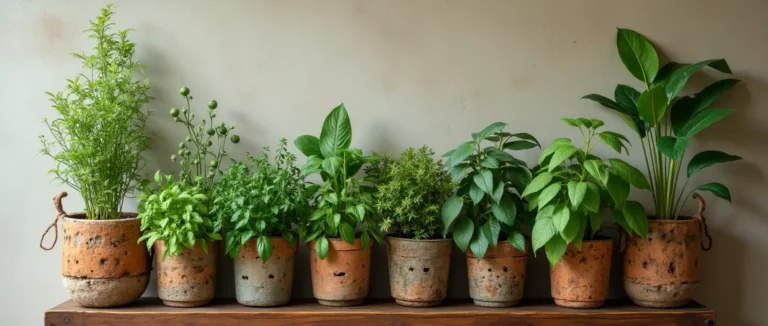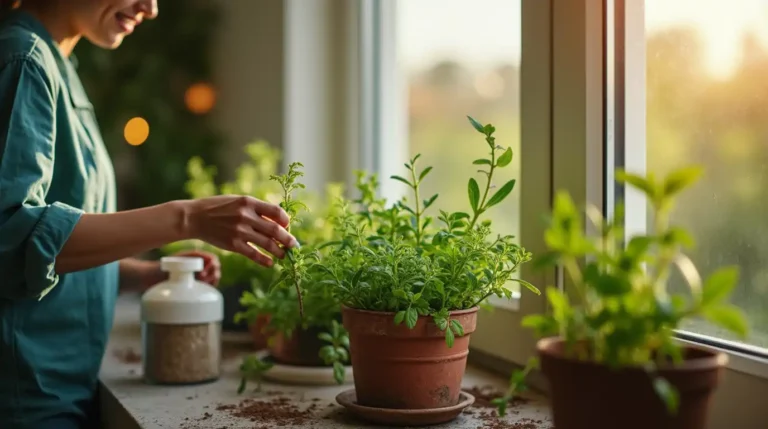Choosing the Right Herbs for Your Balcony’s Microclimate
Introduction
Table of Contents
ToggleThe balcony microclimate refers to the specific climatic conditions of your balcony, which can differ greatly from the general weather in your area. This unique environment is shaped by factors such as sunlight, wind, temperature, and humidity. Understanding your balcony’s microclimate is a crucial step in selecting the right herbs to grow and ensuring their success.
Several factors influence your balcony microclimate, including:
Sunlight exposure: Does your balcony receive direct sunlight all day or only for a few hours?
Wind: Is it consistently windy, or is your balcony relatively sheltered?
Temperature: Is it affected by shade, elevation, or exposure?
Humidity: Is the air dry or naturally humid?
By observing these factors, you can tailor your gardening efforts to optimize your plants’ growing conditions. For instance, a south-facing balcony with abundant sunlight creates a warm balcony microclimate ideal for Mediterranean herbs like rosemary and thyme. Conversely, a shaded north-facing balcony might better suit shade-tolerant herbs such as mint or parsley.
Factors Affecting Your Balcony’s Microclimate
The Role of Sunlight: Direct, Partial, and Full Sun Exposure
Sunlight is one of the most critical factors shaping your balcony microclimate and determining which herbs will thrive. Assessing the amount of sunlight your balcony receives is essential for making the right choices:
Full sun (6+ hours/day): Ideal for herbs like basil, rosemary, and thyme.
Partial sun (3–6 hours/day): Herbs such as mint, parsley, and chives grow well in these conditions.
Shade (less than 3 hours/day): Low-light herbs like coriander or lemon balm will thrive.
Practical Tips for Optimizing Sunlight:
Use a light meter to measure how much sunlight each part of your balcony receives.
If your balcony microclimate lacks adequate sunlight, consider using reflective surfaces like mirrors or light-colored pots to amplify the available light.
Wind and Air Circulation: How They Influence Herb Health
Wind plays a significant role in shaping your balcony microclimate. While good airflow prevents mold and fungal issues, strong winds can damage plants and dry out the soil.
How to Protect Your Plants from Wind:
Install windbreaks, such as trellises, wooden panels, or light fabric screens.
Position pots near walls or corners to reduce direct exposure.
Group your plants together to create a natural barrier and provide mutual protection.
Wind-Resistant Herbs:
Sturdy plants like lavender, sage, and tarragon are excellent choices for windy balcony microclimates. These herbs can withstand strong breezes without significant damage.
Temperature Variations: Understanding Seasonal Changes
Temperatures on a balcony can vary significantly compared to ground-level gardens, especially on higher floors. These fluctuations are an essential aspect of your balcony microclimate and directly affect which herbs you can grow.
In summer: South-facing balconies often become hot, making heat-tolerant herbs like oregano and basil ideal.
In winter: Cooler, shaded balconies are better suited for hardy herbs like mint and chives.
Tips for Managing Temperature:
Use insulated pots or move your plants indoors during extreme cold to protect them from frost.
Monitor the temperature regularly to adapt your planting strategy.
Humidity Levels: Moist vs. Dry Air Conditions
Humidity plays a significant role in the overall health of your balcony microclimate. Understanding whether your balcony tends to be dry or humid helps in choosing appropriate plants:
Naturally humid balconies (e.g., near water sources): Basil, parsley, and coriander thrive in these conditions.
Dry-air balconies: Mediterranean herbs like rosemary, thyme, or sage are well-suited for arid conditions.
How to Increase Humidity Around Plants:
Group pots together to create a micro-environment that retains moisture.
Place water-filled trays beneath pots to add humidity to the surrounding air.
Identifying the Best Herbs for Your Balcony’s Microclimate
Matching Herbs to Specific Environmental Conditions
Understanding your balcony microclimate allows you to select herbs tailored to your space’s conditions. Here are some suggestions:
Sunny and warm conditions: Basil, oregano, rosemary, thyme.
Cool and shaded areas: Mint, parsley, coriander, chives.
Humid balconies: Basil, dill, coriander.
Dry conditions: Lavender, sage, thyme.
Herbs That Thrive in Full Sun
Balconies with abundant sunlight create a warm and productive balcony microclimate perfect for flavorful herbs:
Best Herbs for a Warm, Bright Balcony:
Basil: Requires at least 6 hours of daily sunlight and regular watering.
Rosemary: Thrives in sunny, dry conditions.
Thyme: Low-maintenance and ideal for beginners.
Oregano: Perfect for hot, dry climates and develops intense flavors.
Herbs That Flourish in Partial Shade
Shaded balconies offer unique opportunities to grow herbs that prefer cooler conditions. These areas create a more temperate balcony microclimate:
Choosing Herbs That Need Less Sun Exposure:
Mint: Grows rapidly, even with indirect light.
Coriander: Does well in partial shade.
Parsley: Thrives with moderate sunlight exposure.
Herbs for Windy Balconies: Protection and Resilience
Windy balcony microclimates require resilient herbs and protective measures to ensure success:
Herbs That Are Resilient to Wind:
Sage: Its sturdy leaves make it resistant to wind damage.
Lavender: Its robust structure is ideal for exposed areas.
Tarragon: A hardy herb that tolerates windy conditions well.
Herbs for Cooler Microclimates: Cold-Tolerant Choices
Cooler balconies can still support a productive herb garden by selecting plants that tolerate low temperatures. These conditions create a unique balcony microclimate:
Growing Herbs in Areas with Low Temperatures or Shade:
Mint: Thrives in cooler environments and even tolerates light frost.
Chives: Easy to grow, even in colder climates.
Fennel: A hardy herb that adapts well to lower temperatures.
Planning for Seasonal Changes in Your Balcony Herb Garden
Understanding Your Balcony Microclimate
Your balcony microclimate plays a crucial role in the success of your herb garden. Each balcony has its unique conditions, influenced by sunlight, wind exposure, and temperature variations. Understanding these factors helps you prepare for seasonal transitions and create a stable environment for your herbs throughout the year.
Spring: A Season of Renewal
Spring offers the perfect opportunity to rejuvenate your balcony herb garden. Sow seeds and plant tender herbs like basil and dill, but remain cautious of unpredictable temperature drops. Protect young plants with frost covers or bring them indoors during colder nights.
Summer: Managing Heat and Intensity
The heat of summer benefits sun-loving herbs such as rosemary and thyme. However, intense sunlight and high temperatures can dry out your pots quickly. Use self-watering containers or apply organic mulch to retain soil moisture. Monitor your balcony microclimate closely to shield herbs from heat stress during extreme conditions.
Autumn and Winter: Adapting to Colder Months
In autumn, cooler days signal the need for adjustments. Shift sensitive herbs indoors or to sheltered spots, while hardy herbs like parsley and sage can remain outside with light pruning. Winter, however, demands extra care. Frost-resistant herbs like thyme and oregano can endure the cold, but insulating pots with bubble wrap or relocating them to sunnier spots ensures their survival.
By carefully planning for seasonal changes, you can maintain a thriving herb garden year-round, transforming your balcony into a green sanctuary regardless of the season.
How to Monitor and Adjust Your Balcony Microclimate for Optimal Herb Growth
Tools to Monitor Your Microclimate
Understanding your balcony microclimate is the first step to creating a thriving herb garden. Small changes in temperature, humidity, and sunlight can significantly impact your plants, so having the right tools to monitor your microclimate is essential.
Start with a reliable thermometer to track temperature fluctuations throughout the day. For humidity, a hygrometer is invaluable, especially for herbs that prefer specific moisture levels. Together, these tools help you detect subtle shifts that might otherwise go unnoticed.
To gauge light exposure, invest in a sunlight meter. This device ensures you’re providing the ideal lighting conditions for sun-loving herbs like rosemary or shade-tolerant ones like parsley.
By using these simple yet effective tools, you’ll gain valuable insights into your balcony microclimate, enabling you to make informed decisions and maintain an optimal environment for your herb garden.
Adjusting Your Balcony Setup:
Creating a thriving balcony garden often requires a few clever adjustments to optimize the space. If certain areas of your balcony are shaded, use reflective surfaces to increase light in shaded areas. Mirrors, shiny metal panels, or light-colored pots can amplify sunlight and ensure your plants receive the energy they need to grow.
For balconies exposed to strong winds, it’s crucial to install windbreaks to reduce airflow in exposed spaces. Simple solutions like bamboo screens, glass panels, or even tall potted plants can shield delicate herbs from gusty conditions, preventing damage and excessive drying.
Lastly, group plants together strategically to create a more stable growing environment. Clustering herbs can improve humidity levels and offer mutual protection from environmental stressors, such as heat or wind. These small but effective tweaks will help you craft a balanced and productive growing space for your balcony garden.
Conclusion: Cultivating a Harmonious Herb Garden on Your Balcony
Understanding your balcony microclimate is the key to creating a successful and thriving herb garden. By observing your space, selecting the right plants, and tailoring your approach to the unique conditions of your balcony, you can turn even the smallest outdoor area into a lush herb oasis.
Take the time to experiment, make adjustments, and enjoy fresh, flavorful harvests all year round. With the right care and attention, your balcony microclimate will become the perfect foundation for a flourishing herb garden.
For more tips and tricks on optimizing your balcony microclimate, visit this link






